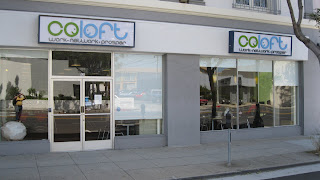 |
| Storefront Entry to CoLoft - Santa Monica, California |
 | |||||
| Office Squared Tree Covered Courtyard (courtesy of O2) |
Simple workstations set up on elegant sawhorses with straightforward table tops were standard. Here and there desktop computers were set up with double screens with workers staring intently into them. Someone came up to me and there I asked If I could take pictures of the inside. He said no as it was against CoLoft policy to respect and protect the privacy of their work community. I asked if the owners were there and could I talk to them?
 | |||
| CoLoft Interior by Brandon Wise, Originally printed in Santa Monica Daily Press |
Shortly after Avesta Rasouli, one of the founders of CoLoft greeted me. I told him I was a vacationing architect just walking by and did he have a moment. He sighed and said, "Unfortunately I'm in the middle of a meeting where I'm looking at expanding my space. Take a look at our website and email me. We'll talk later." And so I did. That moment was a perfect diagram for the growing coworking phenomena, fitting within the "Sharing Economy" as so eloquently identified by Rachel Botswan and Roo Rogers in their exciting book "What's Mine is Yours – the Rise of Collaborative Consumption" published in 2010.
The book talks about the rise of the sharing economy and collaborative consumption fueled by the growth of the internet and dissolving of barriers in trade and communication across geography and time. The rising fluidity of our how easy it is to communicate, organize, work together and shop manifested itself in businesses like Ebay, Craigs List among others. The sharing comes in recognizing there often is available capacity or excess capacity sitting idle of cars, sofas in apartments, hotel rooms laying empty, workers with time on their hands, money underinvested, land available for gardeners. The internet enabled unlikely new configurations of commerce and entrepreneurship impossible to envision only a generation ago. Within this larger movement of the sharing economy coworking emerged.
Botswan and Rogers identified how this movement began with the Spiral Muse Group in 2005 or so whose founding members who ranged from at home professionals, consultants and independent contractors, who realized they "yearned for some form of working community where they could cross-pollinate ideas face to face." Up until then they worked a nomadic existence in coffeehouses and libraries and other spaces but soon found those places wanting for meaningful interactions and places to work effectively. Thus coworking as defined in Wikipedia as "a style of work involving a shared working environment, sometimes an office, yet (with) independent activity." Coworkers often share values or sets of ideals energizing their individual work yet are transformed by "synergies" of unlike but motivated professionals working together, percolating ideas and challenges off of one another.
Coworking spaces can be full off cooperative style intentional working communities to independent businesses run by entrepreneurs who seized the opportunity to develop alternative work settings catering to this new breed of independent tech savvy workers. They realized the most critical aspect of these kind of businesses was not the space or access to shared resources but fostering a true sense of community and connection between members. They are generally not for rent larger scale Office Suites like HQ Global Workplaces or business incubator type spaces as they tend to lack the community appeal of coworking spaces while having many of the same amenities, yet in a more corporate setting.
For those unfamiliar with this trend over the last ten years it's really taken off with coworking spaces now all around the world in most major cities. Fast Company in May published a brief article called Brave New Coworking World where they wrote about the 5M project, a four acre campus with three initial tenants serving up a hybridized version of coworking with Hub SoMa (a more traditional coworking space), TechShop (a so called do it yourself workshop) and Intersection for the Arts (an arts incubator type space). As FC says this growing campus offers both traditional office features with non-traditional options for prototyping and small scale manufacturing of business ideas and products. A veritable dynamo of entrepreneurism and as the website says "radical collaboration".
 |
| View of Office Squared Reception Area |
 |
| View of Office Squared Open Work Area |
 |
| Office Squared Open Area & Conference Room |
Returning back to Vermont, I visited and had multiple conversations with Jen Mincar, the owner of Office Squared. O2's storefront is sandwiched between tall mid-rise turn of the century buildings with a beautiful tree covered plaza in front for outdoor events. Jan said her business is growing like "gangbusters" providing an integral component to help grow Burlington's creative economy saying also her business constantly evolves to match the needs of her members.











